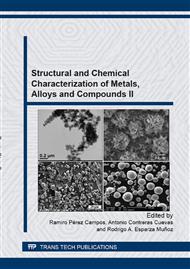[1]
L. Schlapbach, A. Züttel, Hydrogen-Storage Materials for Mobile Applications, Nature 414 (2001) 353–358.
DOI: 10.1038/35104634
Google Scholar
[2]
Z.Y. Deng, J.M. Ferreira, and Y. Sakka, Hydrogen-Generation Materials for Portable Applications, J. Am. Ceram. Soc. 91 (2008) 3825–3834.
DOI: 10.1111/j.1551-2916.2008.02800.x
Google Scholar
[3]
O.V. Kravchenko, K.N. Semenenko, B.M. Bulychev, K.B. Kalmykov, Activation of aluminum metal and its reaction with water, J. Alloys Comp. 397 (2005) 58–62.
DOI: 10.1016/j.jallcom.2004.11.065
Google Scholar
[4]
L. Soler, J. Macanás, M. Muñoz, J. Casado, Aluminum and aluminum alloys as sources of hydrogen for fuel cell applications, Journal of Power Sources 169 (2007) 144-149.
DOI: 10.1016/j.jpowsour.2007.01.080
Google Scholar
[5]
J. Macanás, L. Soler, A.M. Candela, M. Muñoz, J. Casado, Hydrogen generation by aluminum corrosion in aqueous alkaline solutions of inorganic promoters: The AlHidrox process, Energy 36 (2011) 2493-2501.
DOI: 10.1016/j.energy.2011.01.041
Google Scholar
[6]
A.V. Ilyukhina, O.V. Kravchenko, B.M. Bulychev, E.I. Shkolnikov, Mechanochemical activation of aluminum with gallams for hydrogen evolution from water, International Journal of Hydrogen Energy 35 (2010) 1905-1910.
DOI: 10.1016/j.ijhydene.2009.12.118
Google Scholar
[7]
A.V. Parmuzina, O.V. Kravchenko, Activation of aluminum metal to evolve hydrogen from water, International Journal of Hydrogen Energy 33 (2008) 3073-3076.
DOI: 10.1016/j.ijhydene.2008.02.025
Google Scholar
[8]
O.V. Kravchenko, K.M. Semenenko, B.M. Bulychev, K.B. Kalmykov, Activation of aluminum metal and its reaction with water, Journal of Alloys and Compounds 397 (2005) 58-62.
DOI: 10.1016/j.jallcom.2004.11.065
Google Scholar
[9]
M.Q. Fan, F. Xu, L.X. Sun, Studies on hydrogen generation characteristics of hydrolysis of the ball milling Al-based materials in pure water, International Journal of Hydrogen Energy 32 (2007) 2809-2815.
DOI: 10.1016/j.ijhydene.2006.12.020
Google Scholar
[10]
E. Czech, T. Troczynski, Hydrogen generation through massive corrosion of deformed aluminum in water, International Journal of Hydrogen Energy 35 (2010) 1029-1037.
DOI: 10.1016/j.ijhydene.2009.11.085
Google Scholar
[11]
B. Alinejad, K. Mahmoodi, A novel method for generating hydrogen by hydrolysis of highly activated aluminum nanoparticles in pure water, International Journal of Hydrogen Energy 34 (2009) 7934-7938.
DOI: 10.1016/j.ijhydene.2009.07.028
Google Scholar
[12]
K. Mahmoodi, B. Alinejad, Enhancement of hydrogen generation rate in reaction of aluminum with water, International Journal of Hydrogen Energy 35 (2010) 5227-5232.
DOI: 10.1016/j.ijhydene.2010.03.016
Google Scholar
[13]
H.W. Wang, H.W. Chung, H.T. Teng, G. Cao, Generation of hydrogen from aluminum and water-Effect of metal oxide nanocrystals and water quality, International Journal of Hydrogen Energy 36 (2011) 15136-15144.
DOI: 10.1016/j.ijhydene.2011.08.077
Google Scholar
[14]
Z.Y. Deng, Y.B. Tang, L.L. Zhu, Y. Sakka, J. Ye, Effect of different modification agents on hydrogen-generation by the reaction of Al with water, International Journal of Hydrogen Energy 35 (2010) 9561-9568.
DOI: 10.1016/j.ijhydene.2010.07.027
Google Scholar
[15]
M. Bobby Kannan, V.S. Raja, R. Raman, A.K. Mukhopadhyay, Influence of multistep aging on the stress corrosion cracking behavior of aluminum alloy 7010, Corrosion 59 (2003) 881-889.
DOI: 10.5006/1.3287709
Google Scholar
[16]
G. Lu, E. Kaxiras, Hydrogen Embrittlement of Aluminum: the Crucial Role of Vacancies, Physical Review Letters 94 (2005) 155501.
DOI: 10.1103/physrevlett.94.155501
Google Scholar
[17]
T. Takasugi, Hydrogen embrittlement of L12-type Ni3 (Al, Ti) single crystals, Acta Metallurgica et Materialia 39 (1991) 2157-2167.
DOI: 10.1016/0956-7151(91)90185-4
Google Scholar
[18]
T. Takasugi, High-temperature ordered intermetallic alloys IV, MRS Symp. Proc. 213 (1991) 403.
Google Scholar
[19]
T. Takasugi, Critical Issues in the Development of High Temperature Structural Materials, TMS Publication (1993) 399.
Google Scholar
[20]
C.T. Liu, O. Izumi (ed.), 6th JZM International Symposium on Intermetallic Compounds - Structure and Mechanical Properties, Japan Inst. Met (1991) 703.
Google Scholar
[21]
C.T. Liu, R.W. Cahn, G. Sauthoff, Ordered Intermetallics-Physical Metallurgy and Mechanical Behavior, Kluwer Academic Publishers (1992) 321.
DOI: 10.1007/978-94-011-2534-5
Google Scholar
[22]
R.J. Giese, Acta Crystallographica Section B 32 (1976) 1719–1723.
Google Scholar
[23]
M.W. Chase, NIST-JANAF Thermochemical Tables Fourth Edition Part II Cr-Zr, American Institute of Physics, New York, 1998.
Google Scholar
[24]
R.J. Giese, Acta Crystallographica Section B 32 (1976) 1719–1723.
Google Scholar
[25]
E. Wolska, W. Szajda, Use of infrared spectroscopy to identify crystalline aluminum hydroxides, Plenum Publishing Corporation (1983) 137-140.
DOI: 10.1007/bf00659871
Google Scholar
[26]
X.Y. Chen, H.S. Huh, S.W. Lee, Hydrothermal synthesis of boehmite (g-AlOOH) nanoplatelets and nanowires: pH-controlled morphologies, Nanotechnology 18 (2007) 285608.
DOI: 10.1088/0957-4484/18/28/285608
Google Scholar
[27]
G. Huang, S.Y. Liu, Y.A. Guo, A.P. Wang, J. Luo, C.C. Cai, Immobilization of manganese tetranylporphyrin on boehmite and its catalysis for aerobic oxidation of cyclohexane, Applied Catalysis A: General 358 (2009) 173-179.
DOI: 10.1016/j.apcata.2009.02.011
Google Scholar
[28]
A. Violante, P.M. Huang, Formation mechanism of aluminum hydroxide polymorphs, Clays and Clay Minerals 41 (1993) 590-597.
DOI: 10.1346/ccmn.1993.0410509
Google Scholar
[29]
H. Elderfield, J.D. Hem, The development of crystalline structure in aluminum hydroxide polymorphs on ageing, Mineralogical Magazine 39 (1973) 89-96.
DOI: 10.1180/minmag.1973.039.301.14
Google Scholar
[30]
J.T. Kloprogge, H.D. Ruan, R.L. Frost, Thermal decomposition of bauxite minerals: infrared emission spectroscopy of gibbsite, boehmite and diaspore, Journal of Materials Science 37 (2002) 1121-1129.
Google Scholar


